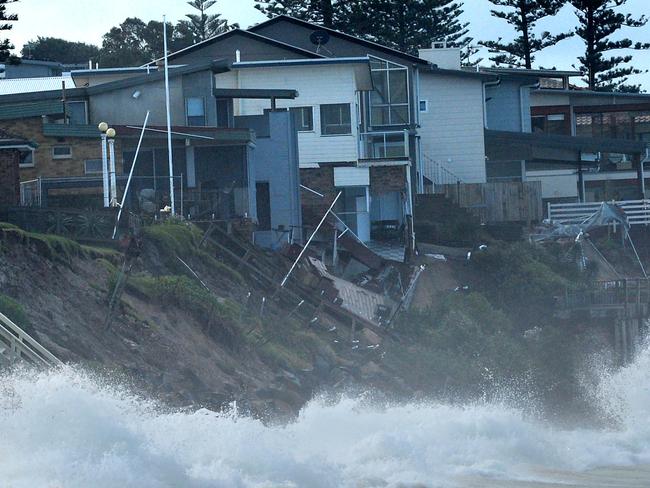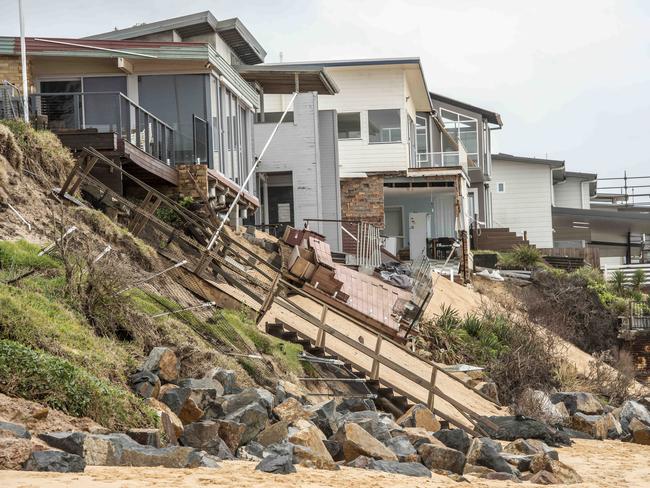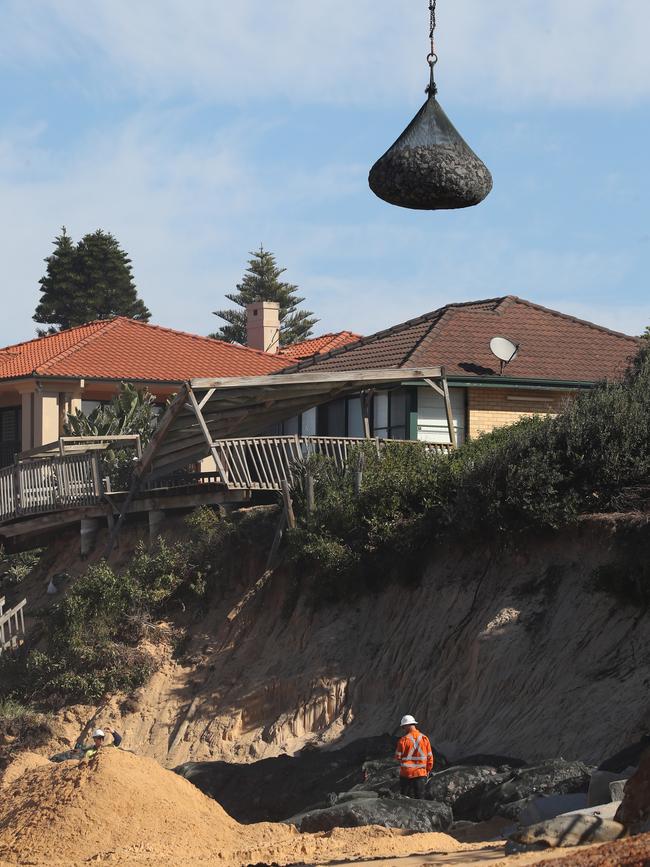Wamberal erosion: Central Coast Council reveals preferred option for seawall
A Wamberal Beach seawall must have a narrow footprint and be as far “landward as possible”. Council has revealed its preferred design options, location and cost benefit analysis.
Central Coast
Don't miss out on the headlines from Central Coast. Followed categories will be added to My News.
Vertical seawall options behind the existing coastal protection works have emerged as the preferred designs for Wamberal Beach.
Central Coast Council has revealed it has hit a milestone in its plans for a long-term strategy for the coastline plagued by erosion.
The council has released its review on the Wamberal Beach Terminal Protection and Sand Nourishment Investigation project along with a cost-benefit analysis with its preferred criteria for a seawall design.
The two preferred designs are option three – a vertical seawall with periodic sand nourishment at a cost of $37m – and option four – a vertical seawall with rocktoe and periodic sand nourishment at a cost of $38m.

Preferred criteria for a seawall were identified by Manly Hydraulics Laboratory’s (MHL’s) technical studies, which included community consultation. They are:
■ The asset to be located as far landward as possible, to reduce interaction with coastal processes and maximise beach width
■ It will be located wholly on private property where possible and
■ The asset to be constructed, owned and maintained by property owners
■ The Seawall to have the narrowest footprint, to reduce erosion/beach encroachment
■ It will have the least sand nourishment requirements, both upfront and during the maintenance phase
The council states that while vertical seawalls have emerged as the preferred options, similar designs would also be explored.
Long term plans for Wamberal Beach have been in the wings for many years with the latest erosion event in July/August 2020 where homes partly crumbled into the ocean and residents forced to evacuate.


Council’s chief executive officer David Farmer said by identifying a long-term solution, council was fulfilling its role as a certifying authority for development.
“By completing the Wamberal Beach Terminal Protection and Sand Nourishment Investigation project, Council has delivered on some key management actions of the certified Coastal Zone Management Plan (CZMP),” Mr Farmer said.
“The review of all expert technical studies, extensive community consultation and consideration of Council’s role and legislative responsibility in relation to coastal erosion have highlighted specific criteria for a preferred seawall design as the most effective and viable long-term solution for beach erosion at Wamberal.
“The preferred seawall design will have the least impact on the beach, as it will be located behind current ad hoc coastal protection works. Those ad hoc works would then be removed which results in greater beach width.

Mr Farmer said no action would result in coastal erosion continuing to threaten homes, public infrastructure and expose ad hoc structures.
“Beach erosion will incrementally get worse and require a continuation of expensive emergency works that are not designed for a long-term solution or a holistic approach,” Mr Farmer said.
“Works undertaken in an emergency situation are not only costly and ineffective for the long term, but they also detract from beach aesthetics and amenity and can potentially impact beach safety for the community.
“Council’s role as a local government entity is to serve the community – which includes both residents and visitors who use the beach, as well as landowners who have the legal right under an approved development application to protect their properties. However, works must not negatively impact beach access, public amenity, neighbouring properties, and the health of our coastlines.

Council is now looking to engage coastal engineers to develop Minimum Engineering Guidelines which will outline more specific criteria to guide coastal protection development applications at Wamberal Beach. These include minimum footprint, length of construction, material selection, landscaping, and maintenance requirements.
Mr Farmer said the guidelines would reflect what the community said was of value and importance during the consultation period.
Council’s Administrator Rik Hart said the community has been waiting a long time for a long-term strategy to address coastal erosion at Wamberal Beach.
“I acknowledge that there are some groups and residents that are opposed to a sea wall and I understand their concerns,” he said.
“However, by not progressing with a viable long-term solution for coastal erosion at Wamberal it will only get incrementally worse and require additional emergency works which would negatively impact beach aesthetic and usability.
“The community can rest assured that all options have been investigated and relevant considerations undertaken to reach this milestone of identifying a viable strategy.”
The community page Wamberal Beach SOS Save our Sand has been vocal on the issue, expressing concerns that a seawall would result in the loss of the beach.
The cost benefit analysis is out for public comment until Sunday March 20 at yourvoiceourcoast.com





